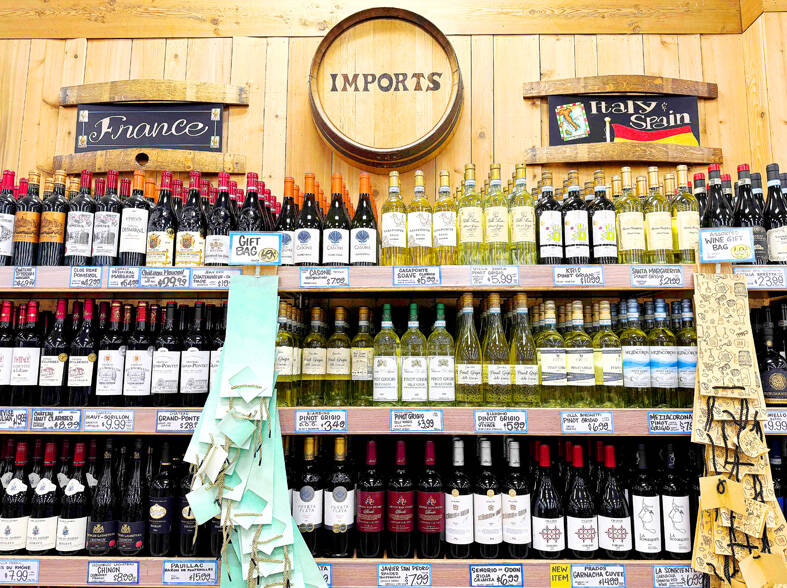US President Donald Trump threatened to impose a 200 percent tariff on wine, champagne and other alcoholic beverages from France and elsewhere in the EU, the latest escalation in a growing transatlantic trade war.
Trump in a social media post on Thursday said that he would move forward with the import duties if Brussels follows through with a tax on US whiskey exports, a measure aimed at retaliating against Trump’s steel and aluminum tariffs that went into effect on Wednesday.
“If this Tariff is not removed immediately, the U.S. will shortly place a 200% Tariff on all WINES, CHAMPAGNES, & ALCOHOLIC PRODUCTS COMING OUT OF FRANCE AND OTHER E.U. REPRESENTED COUNTRIES,” Trump said about the pending levies on bourbon. “This will be great for the Wine and Champagne businesses in the U.S.”

Photo: AFP
Trump on Thursday said he would not repeal tariffs on steel and aluminum that took effect this week, nor back off plans for sweeping reciprocal tariffs on global trading partners set to start as soon as April 2.
Trump is “escalating the trade war he chose to unleash,” French Minister Delegate for Foreign Trade and French Nationals Abroad Laurent Saint-Martin wrote on X. “We will not give in to threats and will always protect our industries.”
The US president on Thursday again aired his grievances against the EU, this time citing its treatment of US tech companies.
“They’re suing Google, they’re suing Facebook, they’re suing all of these companies, and they’re taking billions of dollars out of American companies, many more than the ones I just mentioned. And I guess they’re using it to run Europe or something. I don’t know what they’re using it for, but they treat us very badly,” Trump said.
In response to Trump’s metals tariffs, the EU is planning countermeasures with duties on as much as 26 billion euros (US$28.20 billion) worth of US products.
The EU would also immediately begin consultations with member states, with the aim of adopting the additional lists of agricultural and industrial goods subject to tariffs as high as 25 percent by mid-April.
Meanwhile, US importers, distributors and retailers selling French champagne and Italian wines said the tariffs on European alcoholic drinks would hit them hard.
Mary Taylor, owner of European wine importer Mary Taylor Wine, said that she has 16 shipping containers of wine in transit — an amount that would wipe out her entire net worth if 200 percent tariffs were applied.
Under US law, alcohol producers cannot sell directly to consumers, bars or restaurants. Instead, producers must sell to importers or distributors, who sell products to bars and restaurants.
That means European wines are mostly imported by about 4,000 small US importers and distributors, said Ben Aneff, president of the US Wine Trade Alliance, which advocates against tariffs on wine.
It is US businesses that have to pay the levies, Aneff said, adding that US retailers and restaurants would also suffer if suppliers hike prices to cover the costs.
“A 200% tariff on imported wine would... destroy US businesses,” he said. “It would do significantly more economic damage here in the US than it would in Europe.”

The US dollar was trading at NT$29.7 at 10am today on the Taipei Foreign Exchange, as the New Taiwan dollar gained NT$1.364 from the previous close last week. The NT dollar continued to rise today, after surging 3.07 percent on Friday. After opening at NT$30.91, the NT dollar gained more than NT$1 in just 15 minutes, briefly passing the NT$30 mark. Before the US Department of the Treasury's semi-annual currency report came out, expectations that the NT dollar would keep rising were already building. The NT dollar on Friday closed at NT$31.064, up by NT$0.953 — a 3.07 percent single-day gain. Today,

‘SHORT TERM’: The local currency would likely remain strong in the near term, driven by anticipated US trade pressure, capital inflows and expectations of a US Fed rate cut The US dollar is expected to fall below NT$30 in the near term, as traders anticipate increased pressure from Washington for Taiwan to allow the New Taiwan dollar to appreciate, Cathay United Bank (國泰世華銀行) chief economist Lin Chi-chao (林啟超) said. Following a sharp drop in the greenback against the NT dollar on Friday, Lin told the Central News Agency that the local currency is likely to remain strong in the short term, driven in part by market psychology surrounding anticipated US policy pressure. On Friday, the US dollar fell NT$0.953, or 3.07 percent, closing at NT$31.064 — its lowest level since Jan.

The New Taiwan dollar and Taiwanese stocks surged on signs that trade tensions between the world’s top two economies might start easing and as US tech earnings boosted the outlook of the nation’s semiconductor exports. The NT dollar strengthened as much as 3.8 percent versus the US dollar to 30.815, the biggest intraday gain since January 2011, closing at NT$31.064. The benchmark TAIEX jumped 2.73 percent to outperform the region’s equity gauges. Outlook for global trade improved after China said it is assessing possible trade talks with the US, providing a boost for the nation’s currency and shares. As the NT dollar

The Financial Supervisory Commission (FSC) yesterday met with some of the nation’s largest insurance companies as a skyrocketing New Taiwan dollar piles pressure on their hundreds of billions of dollars in US bond investments. The commission has asked some life insurance firms, among the biggest Asian holders of US debt, to discuss how the rapidly strengthening NT dollar has impacted their operations, people familiar with the matter said. The meeting took place as the NT dollar jumped as much as 5 percent yesterday, its biggest intraday gain in more than three decades. The local currency surged as exporters rushed to